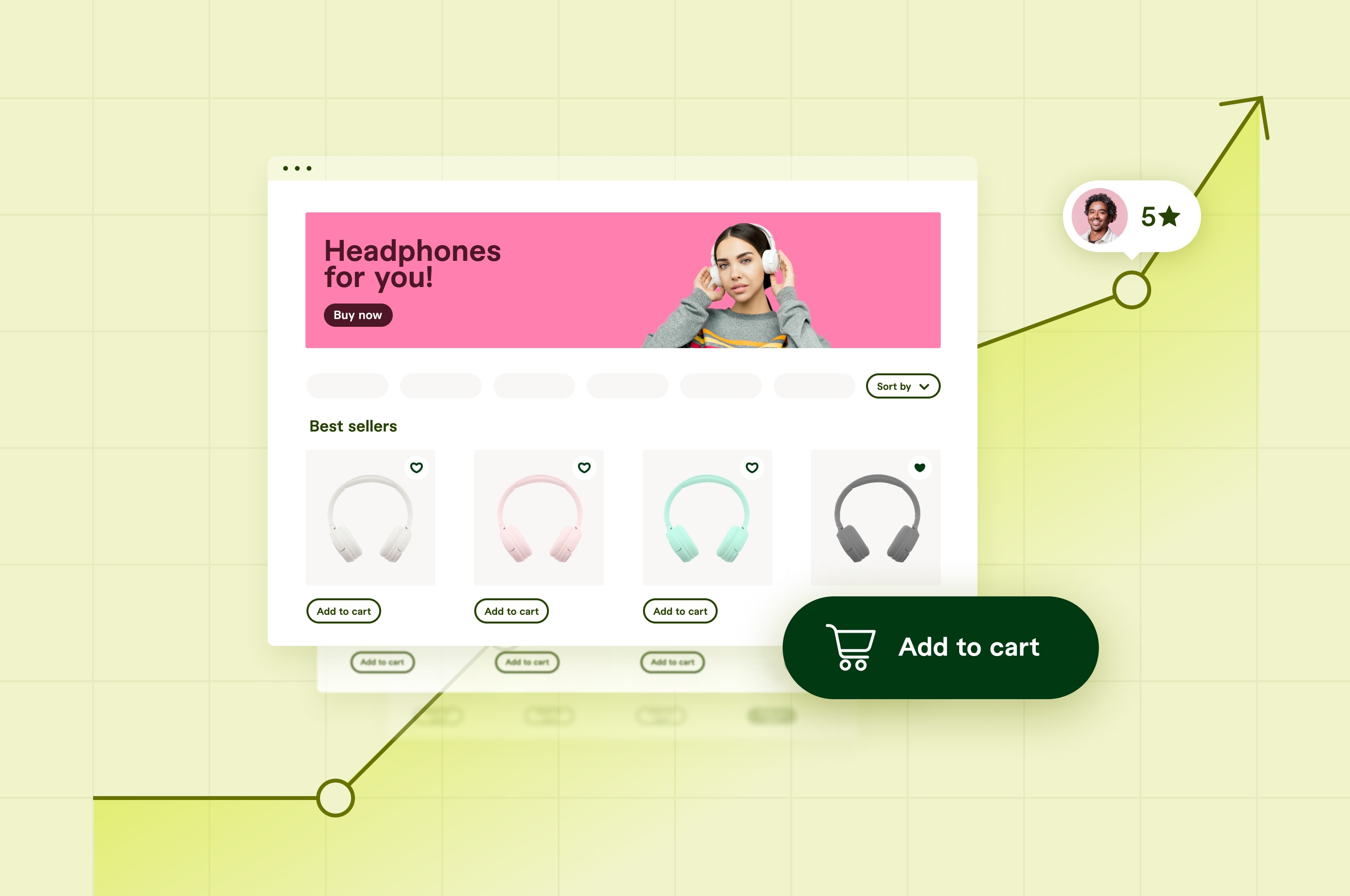SEO for Ecommerce: What it is, How to Use it, and Why
Optimize your ecommerce store for search and start growing your brand’s online visibility by employing the latest SEO trends.
 March 18, 2024
March 18, 2024 9 minute reading
9 minute reading
Ecommerce stores compete against thousands of other online stores for valuable traffic and sales.
To gain more visibility, you need a search engine optimization (SEO) strategy that targets your ideal customers and drives conversions.
So in this article, we'll provide an overview of SEO for ecommerce and explain why it's important for online stores. We'll also discuss the different trends and strategies to use to optimize your website.
Outrank The Competition with Pro E-Commerce SEO Services
What is SEO for ecommerce?
SEO for ecommerce involves strategically optimizing your ecommerce site to rank higher in the search engine result pages (SERPs). Online stores rely heavily on organic traffic to attract potential customers and make sales.
SEO for ecommerce differs slightly from general SEO practices, so it’s important for business owners to know what the algorithms prioritize for ecommerce websites.
It requires understanding SEO and staying abreast of SEO trends, so many ecommerce business owners elect to work with an ecommerce SEO expert.
Why use SEO for an ecommerce store?
The top three organic search results win over two-thirds of all clicks on a Google search page. Gain one of these spots, and you could earn more sales for your online store.
Many online consumers turn to search engines to find new products and services. If you want new customers to discover your brand, then SEO for ecommerce is a must.
Implementing SEO best practices on each page of your website helps boost them to rank in search engines and drive relevant traffic to your store. If your product pages are well-written and speak to the customer, then this will help to increase sales.
It’s a careful balancing act—if you build a store only for people and not search engines, you’ll lose an opportunity to drive high-converting traffic from the SERPs.
But you’re not just creating content to appeal to algorithms—a good ecommerce SEO strategy results in a better user experience overall. You can tailor SEO strategies to your different product niches, such as jewelry, clothing, and plants.
SEO can enhance brand recognition and trustworthiness. Customers are more likely to click on top-ranking sites because they appear reputable because of their high visibility levels.
“SEO played a crucial role when we optimized a category page for ‘Navajo rugs,’ which resulted in a 150% uptick in organic traffic and a corresponding increase in sales for that category,” says Connor Butterworth, CEO and owner of Southwestern Rugs Depot, an ecommerce store that sells rugs. “This was accomplished by implementing structured data, enhancing on-page content with valuable customer-focused information, and acquiring authoritative backlinks.”
SEO for ecommerce best practices
A successful SEO strategy requires a combination of technical expertise, research, and strategic planning. To start optimizing your ecommerce store for SEO, use these seven best practices.
1. Identify the best keywords
One of the most common ecommerce SEO mistakes is targeting the wrong keywords. Many ecommerce stores chase the most popular search terms, only to waste time and resources on non-performing keywords.
Huge companies often rank for the most common target keywords. So consider long-tail keywords—more specific keywords with less search volume but higher conversion rates due to their specificity.
For example, instead of targeting “summer dresses,” target a long-tail keyword like “summer wedding dresses for plus-size women.” Customers who find your store through a specific search like this have a higher chance of converting because it’s an exact match to what they’re shopping for.
Try out some of these keyword research tools to find the right long-tail terms:
Google Keyword Planner
Semrush
Ahrefs
When conducting your keyword research, remember the two types of keywords to improve your on-page SEO. Target both keyword ideas to increase ecommerce SEO success:
Informational keywords. Research intent search terms searchers use when seeking answers and explanations to questions. If you have a blog or FAQ section on your ecommerce store, capitalize on these types of searches.
Commercial keywords. Buying intent keywords searchers use when looking for a product, but don’t know where to buy it from yet. Place these terms on your homepage and product pages to drive more ready-to-buy customers.
2. Implement a sensible site structure
There are two common site structures for ecommerce stores: hierarchical and flat site structures.
A “hierarchical” site structure has fewer primary categories and more subcategories. In this configuration, users are taken further from the homepage because the URLs are more specific.
A "flat" site structure uses more main categories, and users can reach each web pagewith minimal clicks.

Example of a flat site architecture versus a hierarchical—or deep—site architecture. Source
The more simple your site is, the better. This goes for both search engines and customers. Also, consider adding schema markups—HTML tags—to help search engine bots understand your pages and match it to search intent. You’ll likely add more product pages as your business grows, so keep this in mind when setting up your online store’s site architecture.
For an ecommerce store with a lot of products and categories, a flat site structure is ideal to make it easier to search and navigate.
3. Optimize your product pages
Every product needs a product page title. Search engines use these title tags to put your content in front of your target audience. A good product page title should be concise and accurately depict what the product page contains, plus include a target keyword.
For example, if you are selling organic foods, you might include a title, such as 'Organic Peanut Butter.’
Other components of an optimized product page include:
Descriptive product images. Include alt-text captions and name your image’s file name with the right keyword. Compress your images to ensure they load properly and are high quality.
Unique meta descriptions. Your product page’s meta description is another opportunity to convince consumers to choose your website over the others in the SERPs. Keep it under 155 characters and include your target keyword.
Original product descriptions. Write original snippets for each product page description and product name—don’t borrow from competitors or your other pages. Google penalizes duplicate content unless you add a “noindex” or canonical tag to these pages.
“SEO research helps us curate our product category pages and let us know what potential customers are searching for,” says Jason Miller, CEO of PromoLeaf, a sustainable promotional products company. “So, if we see that a certain brand or two are being searched for more than others, we can use that information to tailor marketing content to our existing customer base with specials and discounts for those brands.”

Example of a title tag and meta description for the search “women's summer dresses.”
4. Improve site speed
Site speed and page speed affects how long visitors stay on a website before leaving—aka bounce rate. To improve your technical SEO, strive for page load times below 3 seconds.
Improve site speed by:
Improving server response time
Compressing images
Minimizing external scripts
Reducing HTTP requests
Using caching plugins
Ensure your pages load quickly on desktop and mobile devices. Text should be legible without having to zoom in/out much. This will provide a seamless user experience across all platforms.
5. Add a sitemap
A sitemap is a file on your website with information about all the pages and content on your site. Search engines will look at your sitemap to crawl and understand which pages are most important. Once you have your sitemap, submit it to Google Search Console.
Sitemaps also help users find information on your site that they can’t locate in a drop-down menu. So they make things easier for consumers and crawlers.
6. Create quality content and a quality site
You need to publish quality, original content as a part of your digital marketing strategy.
Leverage content marketing tactics like:
Blogging
Social media promotion
Email marketing
It's better to focus efforts on fewer strategies done well than trying too many things at once—remember, quality over quantity always wins in terms of SEO success. Having content on your ecommerce platform that customers actually want to read also helps your click-through rate (CTR).
Part of creating quality content is building a stunning ecommerce website. The user experience and user interface should be intuitive. Platforms like Shopify come with plenty of templates to choose from. Also, include consistent branding across all pages and a seamless checkout process, alongside these 10 other must-have elements.
7. Employ link building strategies
Google looks at links as a way to trust your ecommerce business. If other authoritative websites are linking back to you, it’s a vote of confidence that boosts your authority. Focus on adding internal links and external links.
Internal links lead visitors to other new pages on your website. They’re helpful for improving your site’s navigation and allow search engines to better understand your site’s structure. External links come from other websites. Be sure to clean up any broken links on your website (pages that lead to deleted or non-existent pages).
SEO for ecommerce trends
As ecommerce continues to grow, the strategies used to optimize for SEO must also evolve. Keeping up with the latest trends can help your business stay ahead of the competition and increase your visibility online.
Here are some of the top trends in SEO for ecommerce to consider.
Don’t have time to monitor all the changes on your own? Consider hiring an SEO expert.
Artificial intelligence
Artificial intelligence (AI) today gives shoppers a more personalized experience. For instance, ecommerce chatbots can help customers complete returns, shop, and answer questions.
A study conducted by BCG found customers prefer a shopping experience that’s easy and fast. AI and machine learning will continue to personalize product recommendations and search results, leading to improved customer experiences and higher conversion rates.
Video content
Video content improves SEO because it engages viewers more effectively than text or images alone. Ninety-six percent of marketers are using video as part of their marketing strategy. The reason: Producing a lot of quality, optimized videos can boost your ranking factors.
Create video content around your ecommerce products to show, not tell customers about your items. You can script educational videos or tutorial videos related to your products.
Hire a video script writer to produce trending video content.
Voice search
The way users shop and search are changing. Many shoppers turn to Amazon’s Alexa or Google Home to find what they want. Sixty-two percent of Americans use a voice assistant on one or more of their devices. So your SEO efforts should concentrate on reaching this group of consumers to capitalize on your brand’s visibility.
Perform an SEO audit and ensure to optimize your site for voice search by:
Using long-tail keywords
Creating content targeted at answering questions
Including natural language
Adding these strategies to your SEO efforts can organically reach a larger demographic and generate more sales for your business.
Augmented reality
Augmented reality (AR) is taking the ecommerce world by storm. AR allows digital information to interact with a shopper’s real world. Retailers use AR to provide customers with an immersive shopping experience.
For example, Sephora uses AR to power its “Virtual Artist” tool, which allows customers to try on their makeup virtually by scanning their faces. Experiences like these are sure to make you stand out from the competition.

Example of Sephora’s virtual product try-on tool. Source
Improve your SEO for ecommerce with freelancers
The world of SEO is constantly evolving, so it’s sometimes best to bring in a professional who keeps up with all the changes. You can work with freelancers to improve your local SEO, video SEO, or offer a full SEO package.
Join Fiverr to access a growing marketplace of expert freelancers who are skilled in various SEO tools and can help you analyze the SEO metrics that matter.



